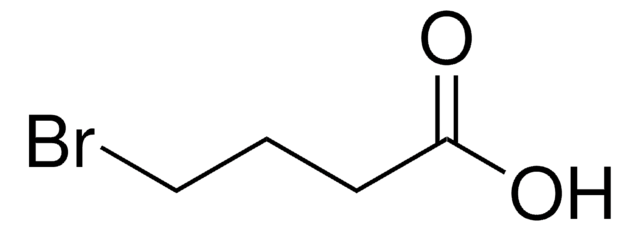200999
12-Bromododecanoic acid
97%
Synonym(s):
12-Bromolauric acid
Sign Into View Organizational & Contract Pricing
All Photos(1)
About This Item
Linear Formula:
Br(CH2)11CO2H
CAS Number:
Molecular Weight:
279.21
Beilstein:
1771588
EC Number:
MDL number:
UNSPSC Code:
12352100
PubChem Substance ID:
NACRES:
NA.22
Recommended Products
Assay
97%
mp
52-55 °C (lit.)
solubility
chloroform: soluble 50 mg/mL, clear to slightly hazy, colorless to faintly yellow
functional group
bromo
SMILES string
OC(=O)CCCCCCCCCCCBr
InChI
1S/C12H23BrO2/c13-11-9-7-5-3-1-2-4-6-8-10-12(14)15/h1-11H2,(H,14,15)
InChI key
YYKBWYBUCFHYPR-UHFFFAOYSA-N
Looking for similar products? Visit Product Comparison Guide
Application
12-Bromododecanoic acid ligand was used as a model fatty acid in the elucidation of the x-ray structure of bovine beta-lactoglobulin.
Storage Class Code
11 - Combustible Solids
WGK
WGK 3
Flash Point(F)
230.0 °F - closed cup
Flash Point(C)
110 °C - closed cup
Personal Protective Equipment
dust mask type N95 (US), Eyeshields, Gloves
Choose from one of the most recent versions:
Already Own This Product?
Find documentation for the products that you have recently purchased in the Document Library.
Customers Also Viewed
G C Roberts
Neurochemical research, 21(9), 1117-1124 (1996-09-01)
NMR spectroscopy has proved to be a valuable tool in the study of the interactions between enzymes and their substrates. The kinds of structural and dynamic information which can be obtained are illustrated by studies of three enzymes involved in
B Y Qin et al.
FEBS letters, 438(3), 272-278 (1998-11-25)
The X-ray structure of bovine beta-lactoglobulin with the ligand 12-bromododecanoic acid as a model for fatty acids has been determined at a resolution of 2.23 A in the trigonal lattice Z form. The ligand binds inside the calyx, resolving a
A simple synthesis of bromine-77-labeled alkyl bromides.
M R Kilbourn et al.
The International journal of applied radiation and isotopes, 33(5), 391-392 (1982-05-01)
S Modi et al.
Biochemistry, 34(28), 8982-8988 (1995-07-18)
The binding of the substrates sodium laurate and sodium 12-bromolaurate to the heme-containing domain of Bacillus megaterium cytochrome P450 BM3 (CYP102) has been studied by measurement of the relaxation effects of the unpaired electrons of the heme iron on the
Xiang He et al.
The Journal of biological chemistry, 280(24), 22697-22705 (2005-04-26)
The fatty acid omega-hydroxylation regiospecificity of CYP4 enzymes may result from presentation of the terminal carbon to the oxidizing species via a narrow channel that restricts access to the other carbon atoms. To test this hypothesis, the oxidation of 12-iodo-
Our team of scientists has experience in all areas of research including Life Science, Material Science, Chemical Synthesis, Chromatography, Analytical and many others.
Contact Technical Service











